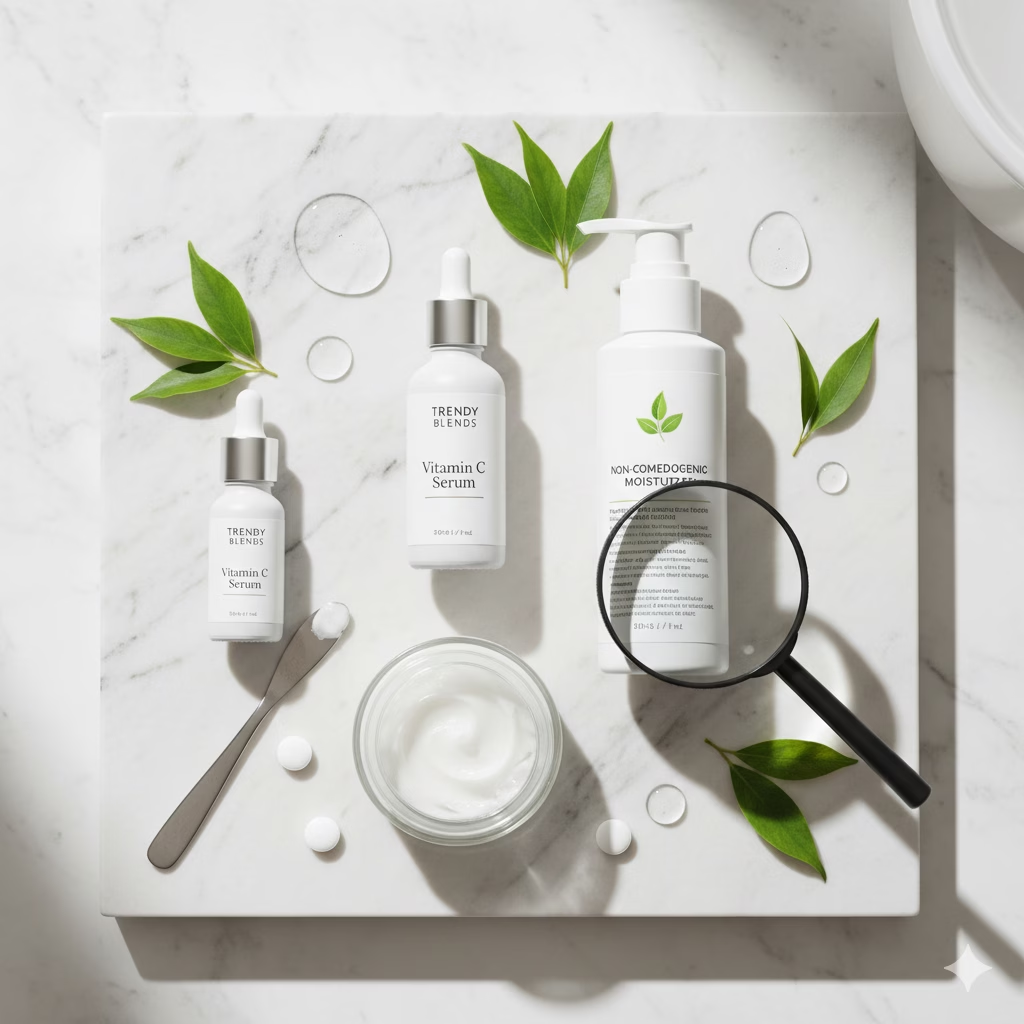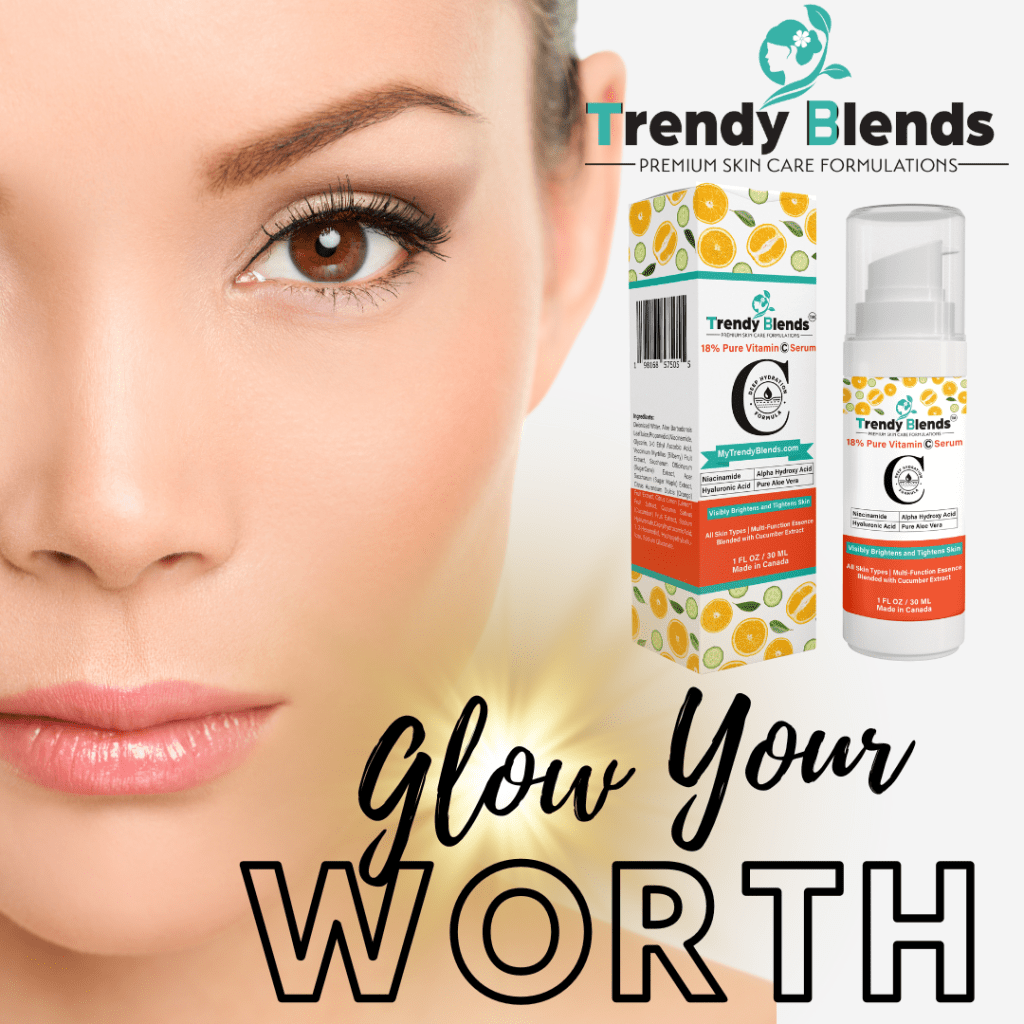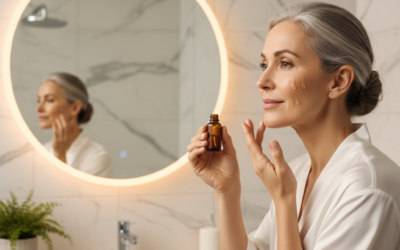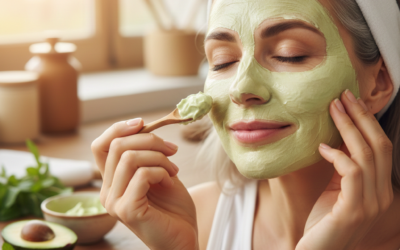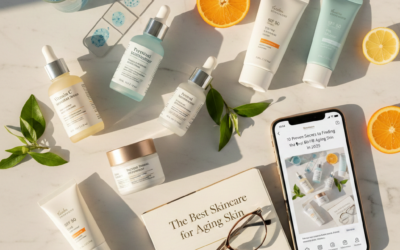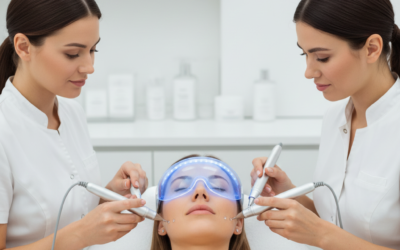3 Steps to Clear Skin: The Ultimate Guide to Non-Comedogenic Moisturizers.
Table of Contents
The Ultimate Guide to Non-Comedogenic Moisturizer: Clear, Hydrated Skin.
Introduction: Why Your Moisturizer Might Be Sabotaging Your Skin
If you struggle with persistent breakouts, stubborn blackheads, or a general feeling of skin congestion, you might be blaming everything from hormones to diet. While those factors play a role, the culprit could be hiding in plain sight: your moisturizer.
For those with oily, combination, or acne-prone skin, hydration is a tightrope walk. You know you need to lock in moisture to maintain a healthy skin barrier and prevent over-secretion of oil (which often happens when skin is dehydrated), yet every moisturizer you try seems to leave you with a fresh crop of clogged pores the next morning.
This is where the term Non-comedogenic moisturizer becomes the single most important filter in your skincare search. The term, derived from comedones (the technical name for clogged pores like blackheads and whiteheads), simply means a product is formulated to avoid pore blockage. Choosing a moisturizer that is truly non-comedogenic is not just about preventing breakouts; it’s about fundamentally respecting the delicate balance of your skin, ensuring it receives deep, soothing hydration without the suffocating side effects of pore-clogging ingredients.
In this definitive, 2000-plus word guide, we will dive deep into the science behind comedogenicity, explain why a Non-comedogenic moisturizer is essential for almost every skin type, uncover the key ingredients you should look for and avoid, and show you exactly how to build a complete, non-congesting routine, including how to perfectly integrate potent actives like Trendy blends vitamin c serum.

Decoding Comedogenicity: Understanding the Clog Factor
The journey to clear skin begins with understanding the single factor that dictates whether a product belongs on your face: its comedogenic rating.
What Are Comedones?
Before diving into the scale, it’s important to clarify what a comedone is. Simply put, a comedone is the earliest form of an acne lesion, representing a plugged follicular orifice.
- Blackheads (Open Comedones): Pores clogged with sebum, dead skin cells, and bacteria, which oxidize when exposed to air, turning dark.
- Whiteheads (Closed Comedones): Pores clogged by the same debris, but covered by a thin layer of skin, preventing oxidation.
Comedogenic ingredients are those that promote the formation of these clogs, ultimately leading to acne breakouts, especially for individuals who are genetically predisposed to congestion.
The Comedogenic Scale (0-5) and Its Caveats
The comedogenic scale is a historical rating system that attempts to quantify an ingredient’s likelihood of clogging pores. The scale ranges from 0 to 5, providing a quick reference guide for consumers [Source 1.1]:
| Rating | Description | Risk of Clogging Pores |
|---|---|---|
| 0 | Non-Comedogenic | Virtually no chance of causing comedones. |
| 1 | Very Low Chance | Highly unlikely to clog pores for most users. |
| 2 | Moderately Low | Might cause congestion in highly acne-prone or sensitive individuals. |
| 3 | Moderate | Caution territory; likelihood of breakouts is higher. |
| 4 | Fairly High | Likely to congest pores and cause pimples if you are acne-prone. |
| 5 | High | Almost certain to cause clogged pores for most users. |
While this scale is widely referenced in skincare circles and is an excellent tool for initial ingredient screening, it’s crucial to understand its limitations [Source 1.2]:
- Animal Testing Origin: The original testing was historically performed on rabbit ears, which are more sensitive and react quicker than human skin. This means the results, while a good indicator, are not a perfect match for the human facial follicle.
- The Concentration Factor: Ingredients were often tested at 100% concentration. In a finished cosmetic product, an ingredient might be diluted to 5% or less. An oil that scores a 4 at full strength might be perfectly fine at a low concentration within a complex formula [Source 1.2, 1.3].
- The Final Formula: A product is more than the sum of its parts. Emulsifiers, solvents, and the overall blend of ingredients can change how a specific oil interacts with the skin. A good formulator can combine several potentially high-scoring ingredients in a way that remains safe for acne-prone skin.
The Takeaway: Use the comedogenic scale as a guiding light, not a rigid law. If you are extremely acne-prone, opting for products where the key ingredients are rated 0-2 gives you the highest probability of success.
The Unrivaled Benefits of a Non-Comedogenic Moisturizer
Why is the label Non-comedogenic moisturizer a non-negotiable step for anyone seeking a clear, balanced complexion? The benefits extend far beyond simply avoiding a breakout.
1. The Foundation of Breakout Reduction
The most obvious and celebrated benefit is the reduction in acne breakouts. Comedogenic products act as a physical barrier, trapping the very things that cause acne: dead skin cells, excess sebum, and Propionibacterium acnes (P. acnes) bacteria.
By using a Non-comedogenic moisturizer, you ensure that the occlusive layer you apply to protect your skin is not contributing to this debris pileup. This minimizes the risk of new pimples, blackheads, and whiteheads forming, allowing your skin to breathe and your pores to remain clear and refined [Source 2.2, 2.4].
2. Balancing Oil Production Without Stripping
Many people with oily skin believe they should skip moisturizer entirely, fearing it will make them greasier. This is a common and counterproductive mistake. When the skin barrier is compromised (often by harsh cleansers or active treatments), the skin overcompensates by producing more sebum, leading to an oilier complexion and more breakouts.
A well-formulated Non-comedogenic moisturizer breaks this cycle. It provides essential hydration without adding heavy, occlusive oils. This signals to your skin that it is adequately moisturized, which helps to regulate and normalize sebum production over time, resulting in a less greasy, more balanced complexion [Source 2.2]. Lightweight, water-based, or gel formulas are often the best textural fit for this purpose.
3. Strengthening the Skin Barrier Function
A healthy skin barrier (the outermost layer of the epidermis) is crucial for retaining moisture and defending against environmental irritants, pollution, and bacteria. When the barrier is weak, skin can become inflamed, red, and susceptible to acne.
Non-comedogenic moisturizers often contain skin-identical ingredients like ceramides, hyaluronic acid, and niacinamide that directly support barrier repair. They deliver profound hydration and essential lipids (fats) without the heavy, pore-blocking potential of highly occlusive ingredients, soothing inflammation and supporting the skin’s natural repair process [Source 2.2].
4. Compatibility with Active Acne Treatments
If you are using prescribed acne treatments like benzoyl peroxide, retinoids, or salicylic acid, you know they can be drying and irritating. A moisturizer is non-negotiable in these routines.
However, layering a comedogenic product over these actives can create a double whammy: inflammation from the active combined with congestion from the occlusive cream. A gentle, Non-comedogenic moisturizer provides the necessary hydration to counteract dryness and sensitivity without compromising the treatment’s ability to clear the pores. It acts as the perfect buffer, ensuring compliance and maximizing the efficacy of your overall acne regimen.
5. Demystifying the Oil-Free vs. Non-Comedogenic Debate
There is a pervasive misconception that “oil-free” automatically means non-comedogenic. This is false.
- Oil-Free means a product contains no mineral, animal, or plant-based oils.
- Non-Comedogenic means the entire formula is designed not to clog pores.
Many synthetic emollients, thickeners, and even some lightweight silicones (which are often “oil-free”) can still score a 3 or higher on the comedogenic scale. Conversely, some highly beneficial, lightweight plant oils—like rosehip seed oil, grapeseed oil, or safflower oil—are naturally low-comedogenic and can be excellent additions to a breakout-prone skin routine [Source 2.1, 4.3].
Therefore, prioritize the Non-comedogenic moisturizer label over the “oil-free” label. Always check the ingredient list for your own personal sensitivities, regardless of the marketing claim.
Elevating Your Routine: Pairing Your Non-Comedogenic Moisturizer with Trendy Blends Vitamin C Serum
Achieving a radiant, clear complexion requires a two-pronged approach: protecting your skin during the day and ensuring a clear pathway for cellular turnover. That’s why the perfect partner to your Non-comedogenic moisturizer is a powerful antioxidant serum, such as the widely praised trendy blends vitamin c serum.
The Power of Vitamin C (L-Ascorbic Acid)
Vitamin C is an essential workhorse in any comprehensive skincare routine, offering benefits that perfectly complement a non-comedogenic approach:
- Antioxidant Defense: When applied in the morning, Vitamin C acts as a shield, neutralizing free radicals generated by UV exposure, pollution, and environmental stress. This boosts your sunscreen’s efficacy and helps prevent premature aging [Source 5.1].
- Brightening and Tone Correction: Vitamin C is a potent inhibitor of melanin production. Consistent use helps to fade hyperpigmentation, including post-inflammatory hyperpigmentation (PIH) left behind by acne and sunspots, leading to a more even, luminous complexion [Source 5.1].
- Collagen Support: As a co-factor in collagen synthesis, Vitamin C helps promote firmness and elasticity, mitigating the signs of aging while improving overall skin texture.
The Synergy: Non-Comedogenic Hydration Meets Antioxidant Protection
The brilliance of pairing the trendy blends vitamin c serum with a Non-comedogenic moisturizer lies in the synergistic effect:
- Optimal Delivery: Vitamin C (especially L-Ascorbic Acid) is typically formulated at a low pH to ensure stability and penetration. Applying it to freshly cleansed skin allows it to penetrate deeply.
- Locking in the Goodness: Once the serum is absorbed (give it 1-2 minutes), the Non-comedogenic moisturizer acts as the crucial sealant. It locks the potent Vitamin C onto the skin, preventing transepidermal water loss and maximizing the antioxidant’s efficacy throughout the day [Source 5.1].
- Calming the Actives: High-potency serums can sometimes cause mild dryness or irritation. The soothing, barrier-supporting ingredients in your non-comedogenic cream immediately calm the skin, ensuring you get all the benefits of the active without the discomfort.
The Correct Layering Sequence (AM Routine)
Proper layering ensures maximal absorption and efficacy. In the morning, follow this simple order:
- Cleanse: Start with a gentle, pH-balanced cleanser.
- Treat (Serum): Apply 2-3 drops of trendy blends vitamin c serum to dry skin and allow it to absorb for a full minute [Source 5.2, 5.3].
- Moisturize (Seal): Apply your Non-comedogenic moisturizer gently across your face and neck to seal in the hydration and the serum.
- Protect (SPF): Never skip this step. Vitamin C boosts UV defense, but it is not a sunscreen. Layer a non-comedogenic, broad-spectrum sunscreen (SPF 30 or higher) over your moisturizer to complete your protection.
The Non-Comedogenic Powerhouse: Key Ingredients to Look For
To confidently select a genuinely safe product, you must become familiar with the hero ingredients that define a high-quality Non-comedogenic moisturizer. These ingredients provide deep hydration and nourishment while maintaining a low comedogenic profile.
1. The Humectants: Water Magnets
Humectants are crucial for hydration as they draw water into the upper layer of the skin (the stratum corneum). They are almost universally non-comedogenic and are the backbone of lightweight, water-based formulas.
- Hyaluronic Acid (Sodium Hyaluronate): A naturally occurring substance capable of holding up to 1000 times its weight in water. It plumps the skin and improves elasticity. It’s a powerful, low-risk hydrator for all skin types, including oily and acne-prone skin [Source 4.3, 2.1].
- Glycerin: An extremely effective and affordable humectant found in virtually all high-quality moisturizers. It draws moisture from the air and deeper layers of the skin, hydrating without causing congestion [Source 4.1].
- Aloe Vera: Known for its soothing properties, aloe vera provides lightweight, water-based hydration and calms irritation [Source 2.1, 4.1].
2. The Skin-Mimicking Emollients and Barrier Supporters
While many heavy emollients clog pores, certain skin-identical or lightweight emollients can soothe and repair the barrier without risk.
- Squalane: A highly stable, non-comedogenic hydrocarbon that mimics squalene, a natural component of human sebum. It provides excellent moisture and softening without feeling greasy [Source 4.1, 2.2]. Squalane is typically rated 0-1 on the comedogenic scale.
- Jojoba Oil (Simmondsia Chinensis Seed Oil): Technically a liquid wax, Jojoba oil closely resembles human sebum. This makes it easily recognized and absorbed by the skin. It is frequently rated 0-2 and can even help dissolve excess sebum buildup in clogged pores, making it an excellent choice for acne-prone skin [Source 4.3, 1.4].
- Niacinamide (Vitamin B3): While not purely a moisturizer, Niacinamide is a powerhouse addition to any Non-comedogenic moisturizer. It helps regulate oil production, minimizes the appearance of pores, calms inflammation (reducing the redness associated with acne), and strengthens the skin barrier [Source 2.1, 4.2].
- Ceramides: These are lipid molecules naturally found in high concentration within the skin barrier. Incorporating ceramides helps replenish the skin’s natural “glue,” reinforcing the barrier and reducing water loss. They are universally non-comedogenic and vital for sensitive skin [Source 4.2].
3. Acne-Targeting Actives that Hydrate
A true multi-tasking Non-comedogenic moisturizer can also include gentle actives that prevent breakouts while hydrating.
- Salicylic Acid (BHA) or Willow Bark Extract: Beta-Hydroxy Acids are oil-soluble, meaning they can penetrate the pore lining to exfoliate from within, dissolving the debris that forms comedones. Willow Bark is a natural source of salicylic acid. When included in a moisturizer, it offers a continuous, low-level decongesting treatment [Source 4.1, 2.2].
Ingredients to Avoid or Approach with Extreme Caution
Understanding the “Don’ts” is just as important as the “Dos” when selecting a Non-comedogenic moisturizer. If you have acne-prone skin, watch out for these ingredients, especially if they are high up on the ingredient list (meaning they are present in a higher concentration):
| Ingredient | Comedogenic Rating (Approx.) | Why to Use Caution |
|---|---|---|
| Coconut Oil (Cocos Nucifera Oil) | 4 | Highly occlusive and high in lauric acid, making it very likely to clog pores for most people [Source 1.4, 4.3]. |
| Cocoa Butter (Theobroma Cacao Seed Butter) | 4 | A very rich, thick butter that creates a heavy, pore-trapping film [Source 1.4, 4.3]. |
| Wheat Germ Oil | 5 | Extremely high likelihood of clogging pores. |
| Algae Extracts | Varies (often 4-5) | Many species, while nutrient-rich, have high comedogenic ratings and should be avoided in leave-on products [Source 4.4]. |
| Mineral Oil / Petrolatum | 0-3 (Varies) | While high-grade, purified mineral oil is often rated 0, its heavy occlusive nature can still trap other debris on the skin, and its purity can vary. |
Recommended Product Textures for Your Non-Comedogenic Moisturizer
The right texture can make all the difference, particularly for the oilier skin type looking for the perfect Non-comedogenic moisturizer.
1. Gel-Based Formulas (Ideal for Oily/Acne-Prone Skin)
Gel moisturizers are typically water-based and contain a high concentration of humectants like hyaluronic acid and glycerin. They absorb instantly, leave a matte or semi-matte finish, and feel weightless. They are the go-to recommendation for individuals with very oily skin or those living in humid climates [Source 2.2]. Look for products containing lightweight silicones (like Dimethicone, rated 1-2) which can smooth the skin and seal in hydration without heavy occlusion [Source 2.1, 4.1].
2. Lightweight Lotions (Ideal for Combination Skin)
Lightweight lotions strike a balance, offering more creamy moisture than a gel but without the richness of a cream. They often use low-comedogenic seed oils (like grapeseed or rosehip) and emollients like Squalane. This texture is perfect for combination skin, hydrating the drier areas (cheeks) while remaining safe for the oilier T-zone.
3. Richer Creams (Ideal for Dry/Sensitive, but Acne-Prone Skin)
If you have genuinely dry skin and are prone to breakouts, you still need occlusive moisture. In this case, look for rich creams that rely on high-grade barrier ingredients (Ceramides, Niacinamide) and highly-vetted, non-comedogenic oils (like Argan oil, rated 1) lower down the ingredient list. These are formulated to provide deep moisture without relying on the most notorious pore-cloggers like Cocoa Butter.
Building the Complete, Clear-Skin Routine: Four Essential Steps
A Non-comedogenic moisturizer is the key component, but it works best when embedded within a routine where every product is selected with pore-health in mind.
Step 1: Gentle, Non-Comedogenic Cleansing
Start with a gentle cleanser that effectively removes dirt, makeup, and excess oil without stripping the skin barrier. A stripped barrier leads to dehydration, which triggers oil overproduction. Look for cleansers specifically labeled non-comedogenic. If you use a double-cleansing oil, ensure the oil is one of the low-comedogenic options like Jojoba or Grapeseed oil.
Step 2: Targeted Active Treatments
This step is where you address your specific concerns.
- AM: Apply your antioxidant treatment, such as the trendy blends vitamin c serum, to protect against environmental damage and brighten the skin.
- PM: Apply a retinoid (to promote cell turnover and prevent clogging) or an AHA/BHA exfoliant (to dissolve dead skin cells).
Step 3: The Non-Comedogenic Moisturizer
This is the lock-it-all-in step. Whether you choose a gel, lotion, or light cream, apply it over your serum. The moisturizer is responsible for restoring water and lipids lost during cleansing and treatment, calming the skin, and maintaining optimal barrier function. This is your skin’s hydration insurance, ensuring comfort and balance [Source 5.1].
Step 4: Sun Protection (SPF 30+)
Sunscreen is the final and non-negotiable step in your morning routine. UV radiation causes inflammation, which can worsen acne and accelerate the breakdown of ingredients like Vitamin C. Choose a mineral or chemical sunscreen that is explicitly labeled Non-comedogenic and provides broad-spectrum protection. Look for lightweight textures that won’t feel heavy or greasy on top of your moisturizer.
Key Takeaways: Your Action Plan for Clear Skin
The choice of your daily hydrator is perhaps the single most important decision for anyone prone to acne or congestion. The label Non-comedogenic moisturizer is your signal that a product is designed with pore health as a primary concern.
- Prioritize the Label: Always choose products clearly labeled as Non-comedogenic or Non-Acnegenic.
- Read the Ingredients: Be proactive. Even with the label, check for high-risk ingredients like Coconut Oil and Cocoa Butter high up on the list. Instead, look for heroes like Hyaluronic Acid, Niacinamide, Squalane, and Jojoba Oil.
- Layer Smartly: Maximize the benefits of powerful serums like the trendy blends vitamin c serum by applying it first to dry, clean skin, and then sealing it in with your non-comedogenic hydrator.
- Listen to Your Skin: The comedogenic scale is not a perfect science. Patch test new products on a small, acne-prone area (like the jawline) before applying them all over. If you don’t break out after a few days, you’ve found a winner [Source 2.1].
By making a conscious switch to a truly Non-comedogenic moisturizer and building a routine focused on gentle hydration and antioxidant protection, you are setting the stage for the clear, radiant, and resilient skin you deserve.
Backlinks and Resources
For further reading and verification of the information presented in this guide, please refer to the following sources:
- Understanding the Comedogenic Scale and Testing:
- The Comedogenic Scale Explained [Source 1.1]
- On Comedogenic and Irritancy Ratings [Source 1.2]
- Comedogenicity Scale: Myths and Realities [Source 1.3]
- Benefits of Non-Comedogenic Products and Ingredient Insights:
- Application and Routine Advice:
- How to Use Vitamin C Serum in Your Skincare Routine [Source 5.1]
- How to Use Vitamin C Serum on Face at Night? [Source 5.2]
- Maximize Your Glow: Layering Vitamin C Serum & Cream [Source 5.4]

